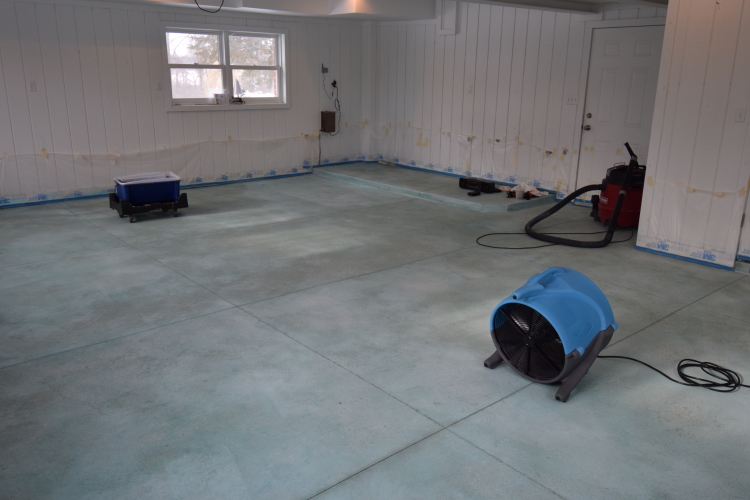Smith Residence
This is a 3-year-old concrete slab in a garage out in the country off of a dirt road. Above left, you can see the dirt and gravel that has accumulated on the unfinished floor. In preparation for acid staining, we wet-cleaned the floor with a rotary floor machine. When it wouldn't dry, we set up a "tenting operation" using plastic sheeting and a dehumidifier (above right).
"Tenting" forces warm, dry air, in a confined space, over damp concrete. After a week, the concrete still wasn't drying. Notice the shadowing caused by the dampness in the photo above left. Ultimately, we had to grind off the dense cement paste on the surface to open up the pores of the concrete and allow the concrete to dry more easily (above right).
Normally, when acid-staining, grinding is avoided because it removes the cement on the surface that the acid stain reacts with, and it exposes fine to medium size aggregate. In this case, however, we had no choice, and we were still able to get a very good staining result (above left). We then sealed the floor to bring out the full color of the stain (above right).
The above photos show the floor before and after from a different vantage point. This particular floor does not have a deep "wet look", like many interior acid-stained concrete floors, because we added non-slip aggregate to the clear coating as a safety precaution for wet conditions. This aggregate is not visible, but it does reduce the gloss of the floor.
The natural mottling effect of the color seen on this floor is something achievable only through the use of acid stain. Dyes and water-based concrete stains available at big box and paint stores will not produce this look. Metallic epoxy, a popular new product for concrete, produces a similar "flowing" effect that many people like, but it is not as"natural" looking.
The next two photos (above) show a common problem encountered with acid stain: if the concrete is not perfectly "clean", the acid stain will not react with it, and you may see patches of non-color - or "blemishes" - across the floor. Dyes, water-based concrete stains, and metallic epoxy cover and conceal spots like these.
A professional acid-staining contractor, however, can still make "blemishes" like these disappear. On this particular spot, caused by leaking hydraulic fluid, we used solvent-based pigment "dispersions" mixed with clear polyurea to match the color of the floor. This type of "faux-finishing" removes all traces of the original blemishes.














